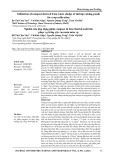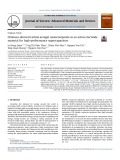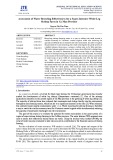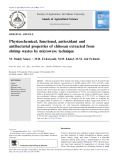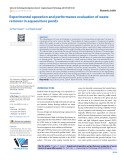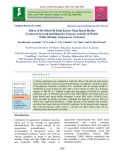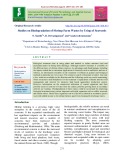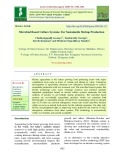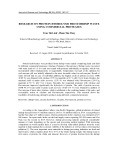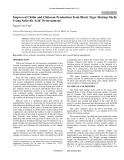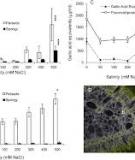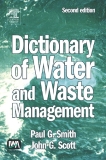
Shrimp waste
-
Compost, an organic fertilizer which is rich of nutrients, safe and environmentally friendly for crop cultivation. In this study, it was aimed at evaluatiton of the effects of the compost derived from shrimp pond waste sludge on plant growth of kohlrabi, white radish, and mustard green.
 12p
12p  vikissinger
vikissinger
 21-12-2023
21-12-2023
 7
7
 1
1
 Download
Download
-
Part 2 book "Seafood science - Advances in chemistry, technology and applications" includes content: Anti aging and immunoenhancing properties of marine bioactive compounds; arsenic in seaweed - presence, bioavailability and speciation; application of bacterial fermentation in edible brown algae; production, handling and processing of seaweeds in indonesia; food applications of by products from the sea; mining products from shrimp processing waste and their biological activities;... and other contents.
 335p
335p  muasambanhan01
muasambanhan01
 13-12-2023
13-12-2023
 6
6
 3
3
 Download
Download
-
The valorization of shrimp wastes to develop advanced materials brings economic and environmental advantages. This paper presents a facile and eco-friendly synthesis of shrimp chitosan-derived carbon (CCS) and CCS/NiO@Ni(OH)2 (CSSN) aerogel nanocomposite for supercapacitor application, in which NiO and Ni(OH)2 nanoparticles were tightly attached to the porous surface of CCS aerogel.
 10p
10p  viberbers
viberbers
 09-08-2023
09-08-2023
 7
7
 3
3
 Download
Download
-
The conversion of the fish and shrimp wastes to produce value-added products brings economic benefits and reduces the risk of environmental pollution. This study presents a facile method for preparing nanohydroxyapatite/chitosan biocomposites (nHCB) for wastewater treatment and bacterial immobilization.
 9p
9p  viberbers
viberbers
 09-08-2023
09-08-2023
 3
3
 3
3
 Download
Download
-
Recycling shrimp farming water is a way to address the trend toward a circular economy in Vietnam's coastal regions while also reducing the quantity of effluent that is released into the environment. In order to explore the potential for waste recycling, this study investigates the pond system of a highly intense Littopenaeus vannamei culture area in Ca Mau province.
 8p
8p  viwhitewolf
viwhitewolf
 11-07-2023
11-07-2023
 4
4
 2
2
 Download
Download
-
Chitosan is produced from shrimp waste chitin at three particle sizes 20, 40 and 60 mesh by deacetylating with different concentrations of NaOH solution (30%, 40% and 50%) under microwave irradiation for 10 min.
 9p
9p  schindler
schindler
 30-12-2021
30-12-2021
 7
7
 0
0
 Download
Download
-
The impacts of waste on shrimp culture environment are determined through analyzing the results of measuring water quality criteria in the pond, thereby assessing the efficiency of waste removal of the equipment. The measurement results show that water quality parameters reach a value within the threshold if operating a waste suction device once per day. The benefits of waste remover operate are to help save the cost of labor to clean the pond bottom, protect workers' health.
 7p
7p  trinhthamhodang9
trinhthamhodang9
 04-12-2020
04-12-2020
 14
14
 1
1
 Download
Download
-
The present study evaluated the use of nonconventional carbon source, de-oiled oil palm kernel meal (Elaeis guineensis), which is a low-cost palm oil industry waste for biofloc production. The effects of de-oiled oil palm kernel meal on water quality, growth and digestive enzyme activity of L. vannamei were studied to assess the viability of this carbon source in biofloc systems.
 11p
11p  trinhthamhodang1215
trinhthamhodang1215
 23-09-2020
23-09-2020
 12
12
 2
2
 Download
Download
-
Biological treatment aims at using plants and animals to reduce nutrients load and particulate matter in shrimp farm discharge. Although extensive literature is available on the different types of shrimp culture practices, its advantages and disadvantages including the impact caused due to enormous application of chemicals such as antibiotics and use of robotics, he information available on the treatment of effluent in general and biological methods in particular are very scarce.
 11p
11p  nguaconbaynhay6
nguaconbaynhay6
 23-06-2020
23-06-2020
 12
12
 0
0
 Download
Download
-
Astaxanthin is a xanthophyll carotenoid, which exhibits many important biological activities including a high degree of antioxidant capacity (AOC) and antibacterial activity, hence has a significant applicability in food, pharmaceutical and cosmetic industries.
 7p
7p  vijiraiya2711
vijiraiya2711
 27-05-2020
27-05-2020
 12
12
 1
1
 Download
Download
-
Marine aquaculture is the fastest growing food producing sector with major contribution from carps in terms of volume and shrimp by value. Continuous development of aquaculture demands new alternative technologies to achieve sustainable production with low economic cost. The microbial based systems like biofloc technology (zero water exchange systems) and artificial substrate integrated (periphyton based) in normal culture systems represents the best methods of practice to get healthy shrimp production.
 23p
23p  nguaconbaynhay3
nguaconbaynhay3
 07-02-2020
07-02-2020
 12
12
 1
1
 Download
Download
-
In this study, factors affecting the extraction yield of carotenoids from dried shrimp waste by organic solvents have been studied. The results showed that the solvent ratio hexane: acetone = 3: 1 gave the highest carotenoid yield. At this ratio of solvent’s mixture, the carotenoid yield reached highest at temperature 60 C after 2 hours extraction, which was 44.64 µg/g raw shrimp waste (d.b.) (ratio of solvent to raw material 3/1). Ultrasound or vortexing gave higher extraction yield than in static conditions, which was 1.8- fold to 1.5- fold increase, respectively.
 7p
7p  chauchaungayxua2
chauchaungayxua2
 07-01-2020
07-01-2020
 9
9
 1
1
 Download
Download
-
Shrimp head waste has been used as raw materials for production of chitin and protein hydrolysate. In this study, a facile and efficient pressing method was developed to separate the solid and liquid phases from shrimp heads. The different solid/liquid ratios as well as the size of the solid component can be obtained easily by changing the pressing operating parameters. The solid fraction was used to prepare chitin and chitosan. This pressing method can save large amount of water and chemicals in the production of chitin and it can be used in the large-scale.
 5p
5p  vidanh27
vidanh27
 08-12-2018
08-12-2018
 21
21
 2
2
 Download
Download
-
Carotenoprotein was extracted by a hydrolysis method using both inorganic and organic acids. Shrimp heads were firstly hydrolyzed by adding a 0.2% (w/v) hydrochloric acid solution at room temperature for an hour following by hydrolyzing with a 0.4% (v/w) formic acid solution for another 2 h at the same temperature. The obtained carotenoprotein consisted of high contents of protein (57.8 wt.%) and carotenoids (473.9 ppm). This method is facile and efficient for the extraction of carotenoprotein from other shrimp and crab wastes on a large scale.
 6p
6p  vidanh27
vidanh27
 08-12-2018
08-12-2018
 22
22
 0
0
 Download
Download
-
Result of study showed that in case of individial addition, the highest yield of protein recovery (YPR 48.88 %) was obtained with Alcalase (375 U/g material) at 50 °C, pH 8 for 4 hours. Besides, the maximal yield of amino acids recovery (2.91 %) was obtained with Flavourzyme (250 U/g material) at 50 °C, pH 7 for 4 hours.
 8p
8p  cumeo3000
cumeo3000
 01-08-2018
01-08-2018
 26
26
 2
2
 Download
Download
-
Abstract: Shrimp chitin and chitosan with improved characteristics were isolated from black tiger shrimp waste pretreated with 0.04 M Salicylic acid for ten hours. The pretreated shrimp shells could be efficiently demineralized and deproteinized at ambient temperature using 0.680 M HCl and 0.620 M NaOH, respectively. The duration of the treatments was 8 hours, the ash and protein residues in the final chitosan were about 0.48% and 0.51% respectively; the viscosity was 4800 cps; the solubility was up to 98%.
 3p
3p  dinhthanhhongts
dinhthanhhongts
 18-04-2013
18-04-2013
 90
90
 8
8
 Download
Download
-
European society and the European economy do not yet exploit the full potential for resource efficiency. Much recyclable waste is either exported or sent to landfill. A lack of long-term frameworks holds back planning and investment, most obviously on a climate and energy framework beyond 2020, but also on long term sustainable use of key resources such as air, soil, energy, water, fish and biomass. At the same time, such frameworks can help to galvanise the innovation needed to exploit the potential of the transition to a low-carbon economy in areas like transport, energy and agriculture....
 18p
18p  lenh_hoi_xung
lenh_hoi_xung
 01-03-2013
01-03-2013
 46
46
 6
6
 Download
Download
-
Much attention has increasingly been paid on safety, health and environmental issues, not only in industry but also in the university. Small scale experiments are safer in lowering the risk of chemical contact, more environmentally friendly, produce less waste and gain many other benefits. Although several universities are familiar with small scale chemistry and some universities have operated small scale chemistry laboratories successfully, several other universities have not yet adopted these practices, particularly for organic chemistry laboratory.
 37p
37p  ut_hai_can
ut_hai_can
 29-12-2012
29-12-2012
 50
50
 2
2
 Download
Download
-
No part of this publication may be reproduced in any material form (including photocopying or storing in any medium by electronic means and whether or not transiently or incidentally to some other use of this publication) without the written permission of the copyright holder except in accordance with the provisions of the Copyright, Designs and Patents Act 1988 or under the terms of a licence issued by the Copyright Licensing...
 493p
493p  em_lanh
em_lanh
 24-04-2011
24-04-2011
 138
138
 38
38
 Download
Download
CHỦ ĐỀ BẠN MUỐN TÌM








